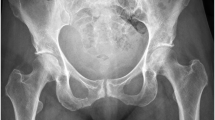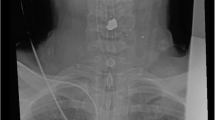Abstract
Study design:
Case report.
Objectives:
To describe a case or traumatic retroclival hematoma with features not previously reported.
Setting:
Single center.
Methods:
Description of a case, in the context of relevant literature on the subject.
Results:
Traumatic retroclival hematomas are a rare, typically pediatric, entity. Only four cases of epidural hematoma in adult patients have been reported. We describe an additional case, the first with a fatal course in the acute setting. It is also the first retroclival hematoma associated to an odontoid base fracture.
Conclusion:
Retroclival hematomas are a rare diagnosis, to be considered in pediatric patients with flexion-extension, high-energy injuries. Morphology is typically epidural. Brain stem and cranial nerve symptoms are typical. Treatment is usually conservative. Outcome is regarded as favorable, with partial recovery and neurologic sequelae. Adult cases are extremely rare. The case we describe adds new characteristics to the scarcity of cases.
Similar content being viewed by others
Introduction
Traumatic retroclival hematomas are a rare entity. Typically, they are epidural hematomas in pediatric patients. Subdural hematomas and adult cases are sporadic. The 35 reported cases include 27 pediatric cases of epidural hematoma, 2 pediatric cases of subdural hematoma, 4 adult cases of epidural hematoma and 2 adult cases of subdural hematoma.1, 2, 3, 4, 5 We describe an additional case of epidural retroclival traumatic hematoma in an adult patient, the first with a fatal outcome in an acute setting and the first associated with an odontoid base fracture.
Case report
A 68-year-old male without relevant medical history, under treatment with AAS 100 mg/24 h, suffered a car accident as a constricted driver. He was brought to the emergency department under cervical immobilization (Philadelphia collar). Initial examination revealed a Glasgow Coma Scale score 15, occipital and chest (seatbelt) bruises, no neurological symptoms and no relevant subjective complaints. An urgent body computed tomography (CT) scan was performed, showing an odontoid fracture type II-A of Anderson-D’Alonzo-Geisler (base fracture with anterior luxation). An epidural hematoma extended from the C2 level to C1 and the retroclival space (Figures 1, 2, 3). No signs of atlanto-occipital dislocation were evident on the CT scan. Additional lesions included fractures of sternum, multiple ribs and multiple lumbar transverse processes. Minutes after the completion of the CT scan, the patient unexpectedly suffered a cardiorespiratory arrest without previous neurological symptoms and without precipitating factors. Resuscitation measures were undertaken, but the patient was pronounced dead shortly afterward.
Discussion
Traumatic retroclival hematomas have been reported only on a sporadic level. They are usually epidural hematomas (being the tectorial membrane the anterior anatomical limit) diagnosed in children in the context of high-energy trauma, typically motor vehicle accidents. Lesion mechanism is considered to be a cervical flexion–extension injury in the pediatric spine that combines ligamentous laxity and high fulcrum movement in the craniocervical junction. In children, associated atlanto-occipital dislocation and systemic injuries have been reported in a significant number of cases, but not as a constant, sine qua non association.1 Brain stem symptoms or multiple cranial nerve palsies are frequently present, management is usually conservative and outcome is generally regarded as good. Similar findings have been reported in the four previously described adult cases with epidural hematomas (Table 1). Three of these four adult patients, and the patient we present, had suffered a high-energy trauma with cranial or cervical bony injuries (bilateral condyle fracture, transverse clivus fracture, C6 transverse process fracture and odontoid base fracture).3, 4, 5 One patient had a whiplash injury with a secondary pontomedullary infarction.2 All patients presented with cranial nerve palsies and two of them with tetraparesis. Only one patient underwent surgical treatment and all had a partial recovery with neurological sequelae. The case we describe is the first adult patient with a fatal course due to epidural retroclival hematoma. Odontoid base fracture has not been previously reported in association with retroclival hematomas of any kind. The fracture was, by type, highly unstable, and in this particular case it displayed a severe anterior luxation. Even so, there was no spinal cord compression due to bony elements and no radiological signs of atlanto-occipital dislocation or vertical instability. The patient had no neurological abnormalities on initial evaluation and he was managed with rigid cervical collar and en bloc mobilization at all times. It is plausible that the odontoid fracture was part of a more extensive discal, capsular or ligamentous cervical injury, but there were no indirect signs of these lesions. Although the acute fatality precluded investigations other than a cervical CT scan, we believe that the hematoma, not the fracture or any occult craniocervical lesion, was the cause of the fatal course.
Conclusion
We present the first adult case of epidural retroclival hematoma with a fatal course and the first case of retroclival hematoma associated with an odontoid base fracture. Pediatric patients, high-energy trauma and flexion–extension injuries seem to be the risk factors associated with these lesions. Management is usually conservative and a partial recovery with residual neurologic deficits is the most frequent outcome.
References
Tubbs RS, Griessenauer CJ, Hankinson T, Rozzelle C, Wellons JC, Blount JP et al. Retroclival epidural hematomas: a clinical series. Neurosurgery 2010; 67: 404–406.
Oliviero A, Insola A, Santilli V, Tartaglione T, Profice P, Tonali P et al. Concomitant post-traumatic cranio-cervical junction epidural hematoma and pontomedullary junction infarction: clinical, neurophysiologic, and neuroradiologic features. Spine (Phila Pa 1976) 2000; 25: 888–890.
Ratilal B, Castanho P, Vara Luiz C, Oliveira Antunes J . Traumatic clivus epidural hematoma: case report and review of the literature. Surg Neurol 2006; 66: 200–202.
Khan N, Zumstein B . Transverse clivus fracture: case presentation and significance of clinico-anatomic correlations. Surg Neurol 2000; 54: 171–177.
Fuentes S, Bouillot P, Dufour H, Grisoli F . [Occipital condyle fractures and clivus epidural hematoma. Case report] [Article in French]. Neurochirurgie 2000; 46: 563–567.
Author information
Authors and Affiliations
Corresponding author
Ethics declarations
Competing interests
The authors declare no conflict of interest.
Rights and permissions
About this article
Cite this article
Pérez-Bovet, J., Garcia-Armengol, R. & Martín Ferrer, S. Traumatic epidural retroclival hematoma with odontoid fracture and cardiorespiratory arrest. Spinal Cord 51, 926–928 (2013). https://doi.org/10.1038/sc.2013.53
Received:
Revised:
Accepted:
Published:
Issue Date:
DOI: https://doi.org/10.1038/sc.2013.53
Keywords
This article is cited by
-
A rare case of retroclival epidural hematoma: case report and review of the literature
Acta Neurologica Belgica (2021)
-
Retroclival epidural haematoma: a diagnosis to suspect. Report of three cases and review of the literature
Acta Neurochirurgica (2017)
-
Isolated traumatic retroclival hematoma: case report and review of literature
Child's Nervous System (2016)






